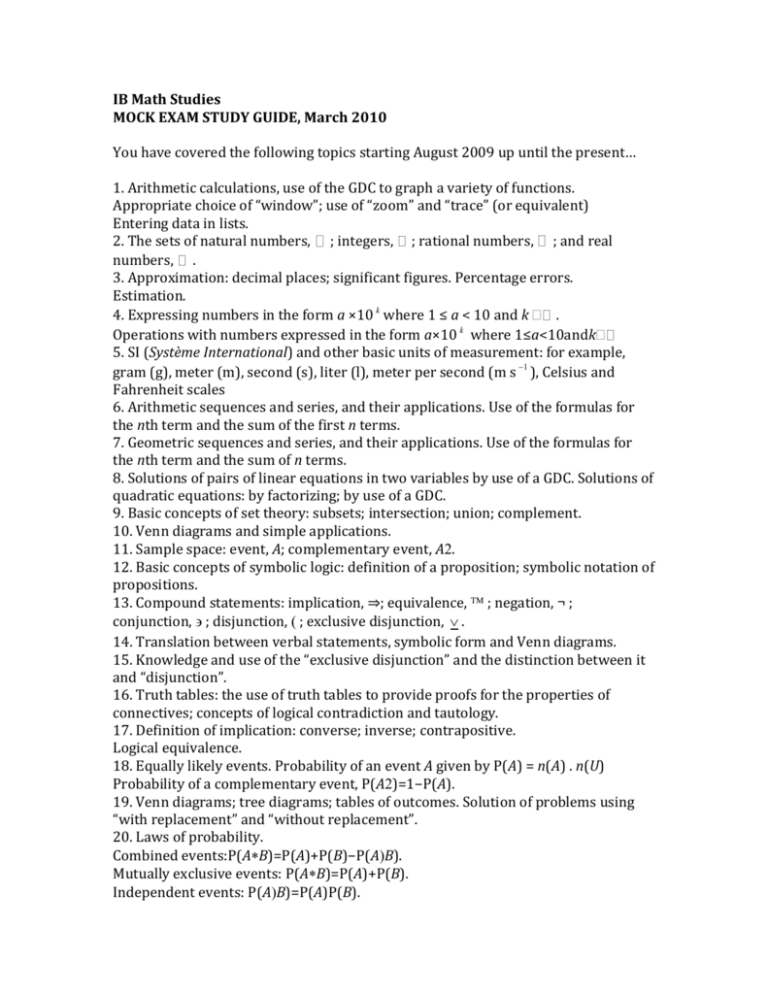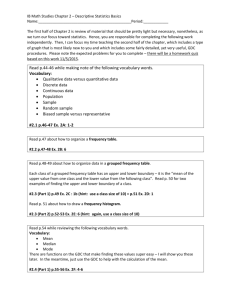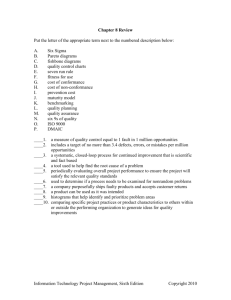IBMathStudies, MOCK EXAM SG, WIKI - Scholl
advertisement

IB Math Studies MOCK EXAM STUDY GUIDE, March 2010 You have covered the following topics starting August 2009 up until the present… 1. Arithmetic calculations, use of the GDC to graph a variety of functions. Appropriate choice of “window”; use of “zoom” and “trace” (or equivalent) Entering data in lists. 2. The sets of natural numbers, ; integers, ; rational numbers, ; and real numbers, . 3. Approximation: decimal places; significant figures. Percentage errors. Estimation. 4. Expressing numbers in the form a ×10 k where 1 ≤ a < 10 and k . Operations with numbers expressed in the form a×10 k where 1≤a<10andk 5. SI (Système International) and other basic units of measurement: for example, gram (g), meter (m), second (s), liter (l), meter per second (m s 1 ), Celsius and Fahrenheit scales 6. Arithmetic sequences and series, and their applications. Use of the formulas for the nth term and the sum of the first n terms. 7. Geometric sequences and series, and their applications. Use of the formulas for the nth term and the sum of n terms. 8. Solutions of pairs of linear equations in two variables by use of a GDC. Solutions of quadratic equations: by factorizing; by use of a GDC. 9. Basic concepts of set theory: subsets; intersection; union; complement. 10. Venn diagrams and simple applications. 11. Sample space: event, A; complementary event, A. 12. Basic concepts of symbolic logic: definition of a proposition; symbolic notation of propositions. 13. Compound statements: implication, ⇒; equivalence, ; negation, ¬ ; conjunction, ; disjunction, ; exclusive disjunction, . 14. Translation between verbal statements, symbolic form and Venn diagrams. 15. Knowledge and use of the “exclusive disjunction” and the distinction between it and “disjunction”. 16. Truth tables: the use of truth tables to provide proofs for the properties of connectives; concepts of logical contradiction and tautology. 17. Definition of implication: converse; inverse; contrapositive. Logical equivalence. 18. Equally likely events. Probability of an event A given by P(A) = n(A) . n(U) Probability of a complementary event, P(A)=1−P(A). 19. Venn diagrams; tree diagrams; tables of outcomes. Solution of problems using “with replacement” and “without replacement”. 20. Laws of probability. Combined events:P(AB)=P(A)+P(B)−P(AB). Mutually exclusive events: P(AB)=P(A)+P(B). Independent events: P(AB)=P(A)P(B). P A B P B 21. Concept of a function as a mapping. Domain and range. Mapping diagrams. 22. Linear functions and their graphs, for example, f : x mx + c . 2 23. The graph of the quadratic function: f(x)=ax +bx+c; Properties of symmetry; vertex; intercepts. 24. The exponential expression: a b ; b Graphs and properties of exponential x x x functions. f (x) = a ; f (x) = a ; f(x)=ka +c; k,a,c,λ Growth and decay; basic concepts of asymptotic behavior. 25. Graphs and properties of the sine and cosine functions: f (x) = asinbx + c ; f(x)=acosbx+c; a,b,c, . Amplitude and period. 26. Accurate graph drawing. 27. Use of a GDC to sketch and analyze some simple, unfamiliar functions. 28. Use of a GDC to solve equations involving simple combinations of some simple, unfamiliar functions. 29. Coordinates in two dimensions: points; lines; midpoints. Distances between points. 30. Equation of a line in two dimensions: the forms y=mx+c and ax+by+d =0. Gradient; intercepts; Points of intersection of lines; parallel lines; perpendicular lines. 31. Right-angled trigonometry. Use of the ratios of sine, cosine and tangent. a b c 32. The sine rule: = = ; The cosine rule a 2 =b 2 +c 2 −2bccosA; sin A sin B sin C 2 2 2 1 b c a cos A ; Area of a triangle: ab sin C 2 2bc 33. Geometry of three-dimensional shapes: cuboid; prism; pyramid; cylinder; sphere; hemisphere; cone. Lengths of lines joining vertices with vertices, vertices with midpoints and midpoints with midpoints; sizes of angles between two lines and between lines and planes. 34. Classification of data as discrete or continuous. 35. Simple discrete data: frequency tables; frequency polygons. 36. Grouped discrete or continuous data: frequency tables; mid-interval values; upper and lower boundaries. Frequency histograms. Stem-and-leaf diagrams. 37. Cumulative frequency tables for grouped discrete data and for grouped continuous data; cumulative frequency curves. Box and whisker plots (box plots). Percentiles; quartiles. 38. Measures of central tendency. For simple discrete data: mean; median; mode. For grouped discrete and continuous data: approximate mean; modal group; 50th percentile. 39. Measures of dispersion: range; interquartile range; standard deviation. 40. Scatter diagrams; line of best fit, by eye, passing through the mean point. Bivariate data: the concept of correlation. Pearson’s product–moment correlation Conditional probability: P( A | B) = coefficient: Use of the formula r = s xy sx sy ; Interpretation of positive, zero and negative correlations. 41. The regression line for y on x: use of the formula y y sxy sx2 x x Use of the regression line for prediction purposes. 42. The 2 test for independence: formulation of null and alternative hypotheses; significance levels; contingency tables; expected frequencies; use of the formula 2 f o fe 2 ; degrees of freedom; use of tables for critical values; p-values. calc fe






